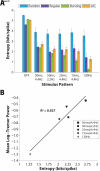Short pauses in thalamic deep brain stimulation promote tremor and neuronal bursting
- PMID: 26330131
- PMCID: PMC4747847
- DOI: 10.1016/j.clinph.2015.07.034
Short pauses in thalamic deep brain stimulation promote tremor and neuronal bursting
Abstract
Objective: We conducted intraoperative measurements of tremor during DBS containing short pauses (⩽50 ms) to determine if there is a minimum pause duration that preserves tremor suppression.
Methods: Nine subjects with ET and thalamic DBS participated during IPG replacement surgery. Patterns of DBS included regular 130 Hz stimulation interrupted by 0, 15, 25 or 50 ms pauses. The same patterns were applied to a model of the thalamic network to quantify effects of pauses on activity of model neurons.
Results: All patterns of DBS decreased tremor relative to 'off'. Patterns with pauses generated less tremor reduction than regular high frequency DBS. The model revealed that rhythmic burst-driver inputs to thalamus were masked during DBS, but pauses in stimulation allowed propagation of bursting activity. The mean firing rate of bursting-type model neurons as well as the firing pattern entropy of model neurons were both strongly correlated with tremor power across stimulation conditions.
Conclusions: The temporal pattern of stimulation influences the efficacy of thalamic DBS. Pauses in stimulation resulted in decreased tremor suppression indicating that masking of pathological bursting is a mechanism of thalamic DBS for tremor.
Significance: Pauses in stimulation decreased the efficacy of open-loop DBS for suppression of tremor.
Keywords: Computational model; Deep brain stimulation; Essential tremor; Movement disorders; Thalamus.
Copyright © 2015 International Federation of Clinical Neurophysiology. Published by Elsevier Ireland Ltd. All rights reserved.
Figures









Comment in
-
Pause for breath: Emerging tremor during syncopated deep brain stimulation.Clin Neurophysiol. 2016 Feb;127(2):1009-1010. doi: 10.1016/j.clinph.2015.11.006. Epub 2015 Nov 18. Clin Neurophysiol. 2016. PMID: 26639169 No abstract available.
Similar articles
-
Effects of ramped-frequency thalamic deep brain stimulation on tremor and activity of modeled neurons.Clin Neurophysiol. 2020 Mar;131(3):625-634. doi: 10.1016/j.clinph.2019.11.060. Epub 2019 Dec 26. Clin Neurophysiol. 2020. PMID: 31978847 Free PMC article.
-
Tremor reduction and modeled neural activity during cycling thalamic deep brain stimulation.Clin Neurophysiol. 2012 May;123(5):1044-52. doi: 10.1016/j.clinph.2011.07.052. Epub 2011 Oct 5. Clin Neurophysiol. 2012. PMID: 21978653 Free PMC article.
-
Closed-loop control of deep brain stimulation: a simulation study.IEEE Trans Neural Syst Rehabil Eng. 2011 Feb;19(1):15-24. doi: 10.1109/TNSRE.2010.2081377. Epub 2010 Sep 30. IEEE Trans Neural Syst Rehabil Eng. 2011. PMID: 20889437
-
Thalamic Deep Brain Stimulation.Prog Neurol Surg. 2018;33:198-206. doi: 10.1159/000481104. Epub 2018 Jan 12. Prog Neurol Surg. 2018. PMID: 29332084 Review.
-
Deep brain stimulation in movement disorders.Semin Neurol. 2007 Apr;27(2):170-82. doi: 10.1055/s-2007-971175. Semin Neurol. 2007. PMID: 17390262 Review.
Cited by
-
Recent Trends in the Use of Electrical Neuromodulation in Parkinson's Disease.Curr Behav Neurosci Rep. 2018;5(2):170-178. doi: 10.1007/s40473-018-0154-9. Epub 2018 Apr 24. Curr Behav Neurosci Rep. 2018. PMID: 29862163 Free PMC article. Review.
-
Temporally non-regular patterns of deep brain stimulation (DBS) enhance assessment of evoked potentials while maintaining motor symptom management in Parkinson's disease (PD).Brain Stimul. 2023 Nov-Dec;16(6):1630-1642. doi: 10.1016/j.brs.2023.10.009. Epub 2023 Oct 19. Brain Stimul. 2023. PMID: 37863388 Free PMC article.
-
Average firing rate rather than temporal pattern determines metabolic cost of activity in thalamocortical relay neurons.Sci Rep. 2019 May 6;9(1):6940. doi: 10.1038/s41598-019-43460-8. Sci Rep. 2019. PMID: 31061521 Free PMC article.
-
Small Changes in Inter-Pulse-Intervals Can Cause Synchronized Neuronal Firing During High-Frequency Stimulations in Rat Hippocampus.Front Neurosci. 2019 Jan 31;13:36. doi: 10.3389/fnins.2019.00036. eCollection 2019. Front Neurosci. 2019. PMID: 30766474 Free PMC article.
-
Optimized temporal pattern of brain stimulation designed by computational evolution.Sci Transl Med. 2017 Jan 4;9(371):eaah3532. doi: 10.1126/scitranslmed.aah3532. Sci Transl Med. 2017. PMID: 28053151 Free PMC article.
References
-
- Ando N, Izawa Y, Shinoda Y. Relative contributions of thalamic reticular nucleus neurons and intrinsic interneurons to inhibition of thalamic neurons projecting to the motor cortex. J Neurophysiol. 1995;73:2470–85. - PubMed
-
- Birdno MJ, Cooper SE, Rezai AR, Grill WM. Pulse-to-pulse changes in the frequency of deep brain stimulation affect tremor and modeled neuronal activity. J Neurophysiol. 2007;98:1675–84. - PubMed
-
- Blomstedt P, Sandvik U, Tisch S. Deep brain stimulation in the posterior subthalamic area in the treatment of essential tremor. Mov Disord. 2010;25:1350–6. - PubMed
Publication types
MeSH terms
Grants and funding
LinkOut - more resources
Full Text Sources
Other Literature Sources
Medical

